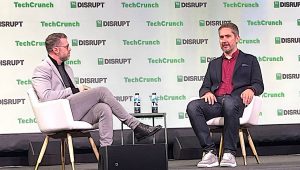 AI
AI
 AI
AI
 AI
AI
Thomas Kurian’s parent company, Alphabet Inc., has $290 billion in annual revenue, and Kevin Systrom’s startup Artifact Inc. is operating on a funding round of $5 million. Despite the disparity the two firms have a common goal, shared with many a company today: to blaze new trails in artificial intelligence that will shape the future for years to come.
Kurian (pictured), chief executive of Google Cloud, made it clear during an appearance at TechCrunch Disrupt in San Francisco this week that despite lagging far behind Amazon Web Services Inc. and Microsoft Corp. in cloud market share, his business’ position in software will make it a major player in AI.
“Today we are third in cloud, but we are the fifth-largest software company in the world,” Kurian said Wednesday. “We run 50% of all the AI startups in the world and 70% of all AI unicorns.”
 Systrom (right), co-founder of Instagram, which was sold to Facebook Inc. in 2012 for $1 billion, now runs the AI-powered news app Artifact. Much as he foresaw that photo sharing on a mobile platform would become a smash success, Systrom believes that the process of news aggregation is ripe for disruption and that AI will drive its future impact.
Systrom (right), co-founder of Instagram, which was sold to Facebook Inc. in 2012 for $1 billion, now runs the AI-powered news app Artifact. Much as he foresaw that photo sharing on a mobile platform would become a smash success, Systrom believes that the process of news aggregation is ripe for disruption and that AI will drive its future impact.
Systrom said today that Artifact is using large language models to understand text and personalize content for its audience, while leveraging AI to find links that will meet user needs for reliable information. “Distribution of content via AI feels like the future to me,” Systrom said.
Writing code using AI is also the future, based on a major bet that Microsoft has made with GitHub Copilot, an AI-powered programming tool for developers. On Wednesday, the cloud giant announced that Copilot Chat had been released in public beta for individual users, and today it announced Copilot in Windows 11.
GitHub, the developer portal acquired by Microsoft in 2018, has been steadily enhancing Copilot since its launch in 2022, and Thomas Dohmke, GitHub’s CEO, appeared at Disrupt on Wednesday to discuss how Copilot and generative AI were making an impact on code generation in the enterprise.
“We are getting to the point where natural language is the way that you are writing code,” Dohmke said. “Software developers are the first part of the workforce that have truly embraced AI. In the near future you will see Copilot Chat in every part of the development cycle.”
AI is also becoming more fully integrated at the device level. This trend was noted as well by Kurian, who said that the evolution of AI will follow a path where smaller models will run at the device level, such as a smartphone, while larger models will likely be executed in the cloud.
“You want to choose the right model for the task,” Kurian said. “The largest model is not always the right one. The smaller models have better latency, they can have lower cost.”
This move of AI to the device level is a development that has been closely followed by chip suppliers to the smartphone market, such as Qualcomm Inc. The chipmaker has been working to integrate models, such as the AI-to-text image rendering solution Stable Diffusion, into the smartphone processing engine.
“Now [AI] is really in the foreground and having it on the device is key,” said Alex Katouzian, senior vice president and general manager of mobile, compute and XR at Qualcomm. “Immediacy, security and privacy really push on-device AI capabilities.”
A major test of AI’s capabilities at the device level is currently playing out on the streets of 14 cities across the United States. Robotaxi maker Cruise Inc. has deployed 150 of its driverless vehicles at night and 50 during the day in San Francisco in what has been a closely watched and somewhat controversial test of autonomous technology.
Cruise co-founder and CEO Kyle Vogt talked about the concept of “fleet learning,” where his company feeds data from every test drive into a continuous learning machine that builds a knowledge base of real-world driving scenarios. His position is that autonomous vehicles or AVs will ultimately lead to safer streets.
“We have the equivalent of several lifetimes of human driving data,” Vogt said. “Our purpose is to get driverless transportation out there because it’s safer. Betting against AVs right now is like saying Facebook is never going to make it because it’s only on college campuses.”
Support our open free content by sharing and engaging with our content and community.
Where Technology Leaders Connect, Share Intelligence & Create Opportunities
SiliconANGLE Media is a recognized leader in digital media innovation serving innovative audiences and brands, bringing together cutting-edge technology, influential content, strategic insights and real-time audience engagement. As the parent company of SiliconANGLE, theCUBE Network, theCUBE Research, CUBE365, theCUBE AI and theCUBE SuperStudios — such as those established in Silicon Valley and the New York Stock Exchange (NYSE) — SiliconANGLE Media operates at the intersection of media, technology, and AI. .
Founded by tech visionaries John Furrier and Dave Vellante, SiliconANGLE Media has built a powerful ecosystem of industry-leading digital media brands, with a reach of 15+ million elite tech professionals. The company’s new, proprietary theCUBE AI Video cloud is breaking ground in audience interaction, leveraging theCUBEai.com neural network to help technology companies make data-driven decisions and stay at the forefront of industry conversations.